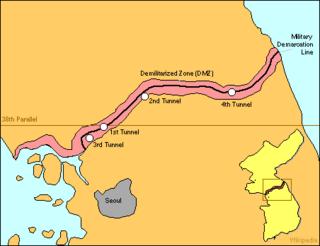DMZ - Words from me and courtesy of a CNN article and Wikipedia Online

Since 1953, the Demilitarized Zone or the DMZ has split the Korean peninsula in half, separating the Communist, Democratic People's Republic of Korea (DPRK) in the north and the Republic of Korea (ROK) in the south. The DMZ was formed after the 3 year Korean War which ended on July 27, 1953. The war ravaged the peninsula, killing tens of thousands, and splitting an otherwise homogenous people between the communist supported north and the American, capitalist supported south. Geographically, the DMZ is situated on the 38th parallel and is split by 2 kilometres on either side. This is where the original borders for North and South Korea were defined, when they were split by the allied powers after World War II. After being liberated from Japanese imperialism at the end of WW II, the Soviet Union and the United States split the peninsula into two spheres of influence based in the North and South respectively. Once statehood was declared independently, each of the two states remained dependent on their super power sponsors for defense, building up governmental institutions and rebuilding the local economies. As one of the active positions of the cold war, North Korea aggressively marched over the 38th parallel in 1950. This sparked off the 3 year long Korean War, in which the United States coupled with the United Nations supported South Korea to invade the North.
It was then in 1953 that only a ceasfire was made and the DMZ continues to exist as a fragile land heavily controlled by military on either side.
Except in the area around the truce village of Panmunjeom and more recently on the Donghae Bukbu Line on the east coast, humans, for the most part, have not entered the DMZ for the last fifty years. This isolation has created, vast untouched land along the DMZ which has now become an important refuge for two of the world's most endangered birds: the white-naped and the red-crowned crane. Also other rare species include Asiatic black bears, Chinese gorhals, shell ducks, swan geese, deers and egrets all co-exist in this untouched area. There are also accounts of Korean tigers in the DMZ -- a sub-species of the Siberian tiger, one of the rarest tigers on the planet. Another fact is that more than 20,000 migratory fowl utilize the border area. The 4-kilometer-wide by 250-kilometer long (2.5 miles by 155 miles) DMZ stretches across the entire width of the Korean Peninsula, encompassing a cross section of ecosystems and landscapes.


0 Comments:
Post a Comment
<< Home